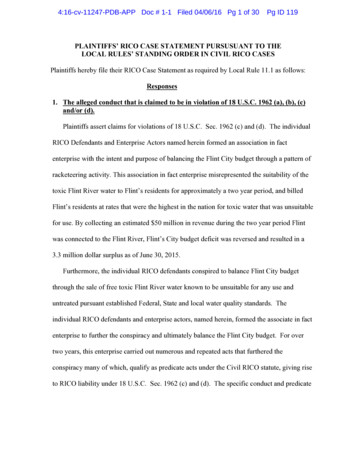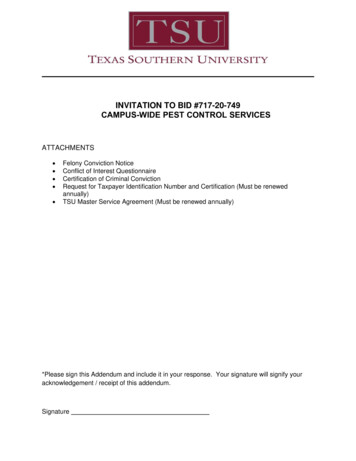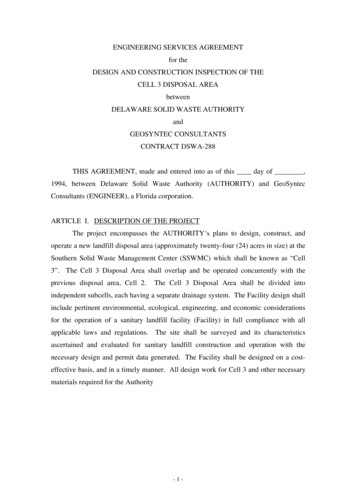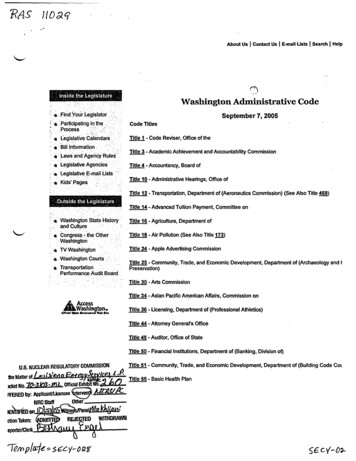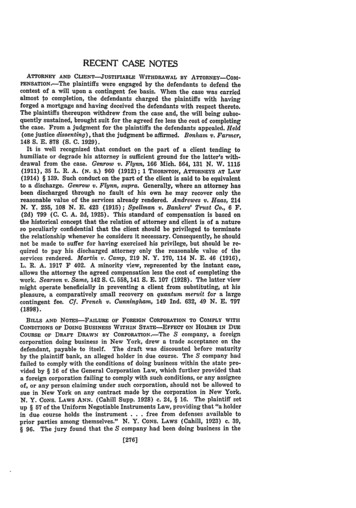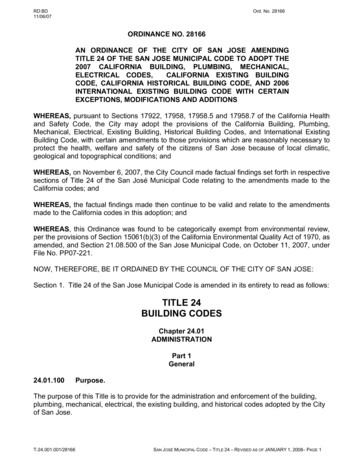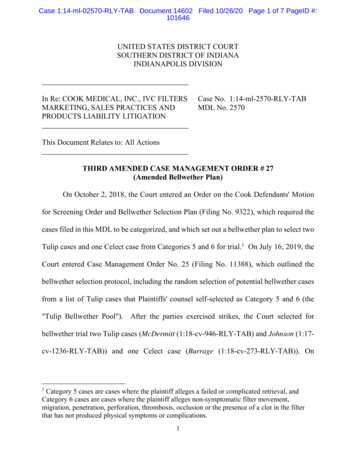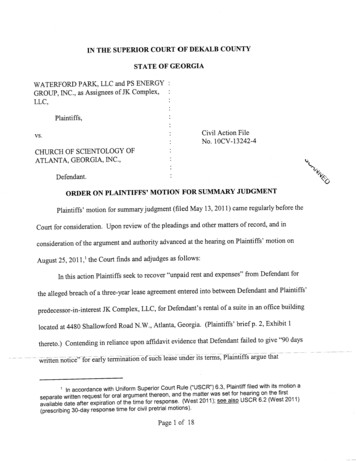
Transcription
Bates et al v. Suntrust Mortgage, Inc. et alDoc. 1712345678UNITED STATES DISTRICT COURT9EASTERN DISTRICT OF CALIFORNIA101112KENNETH A. BATES; HEATHER M.BATES,Plaintiff,13141516171819202122No. 2:13-cv-01402-TLN-DADORDERv.SUNTRUST MORTGAGE, INC., aVirginia corporation; SETERUS, INC., aDelaware corporation; MORTGAGEELECTRONIC REGISTRATIONSYSTEMS, INC., a Delaware corporation,ALL PERSON UNKNOWN, CLAIMINGANY LEGAL OR RQUITABLE RIGHT,TITLE, ESTATE, LIEN OR INTERESTIN THE PROPERTY DESCRIBED INTHE COMPLAINT ADVERSE TOPLAINTIFFS’ TITLE OR ANY CLOUDON PLAINTIFFS’ TITLE THERETO,DOES 1 through 50, inclusive,Defendants.2324This matter is before the Court pursuant to two separate motions to dismiss. Defendants25Seterus, Inc. (“Seterus”) and Mortgage Electronic Registration Systems, Inc. (“MERS”)26collectively filed a Motion to Dismiss Plaintiffs’ Complaint on July 22, 2013. (ECF No. 7.) The27following day, Defendant SunTrust Mortgage, Inc. (“SunTrust”) also filed a Motion to Dismiss281Dockets.Justia.com
1Plaintiffs’ Complaint. (ECF Nos. 8.) Plaintiffs Kenneth A. Bates and Heather M. Bates2(hereinafter collectively referred to as “Plaintiffs”) have filed an opposition to both motions.3(ECF Nos. 10, 11.) The Court has carefully considered the arguments presented by both parties.4For the reasons set forth below, Defendants’ motions to dismiss (ECF Nos. 7, 8) are both5GRANTED.6I.Factual BackgroundOn December 14, 2006, Plaintiffs obtained a primary loan in the amount of 344,000.00178and a secondary loan in the amount of 64,500.00 from the San Francisco Police Credit Union9(“SFPCU”), in order to purchase the real property located at 770 Teton Lane, Tracy, California1095376 (the “subject property”). (Compl., ECF No. 1 at ¶¶ 2, 8, 9.) Each loan was secured by a11Note and a Deed of Trust on the property, in which SFPCU was the trustee. (ECF No. 1 at ¶ 8,129.)13On December 28, 2006, SFPCU assigned all of its rights under both notes and deeds of14trust to SunTrust, as recorded by SFPCU in the official records of the San Joaquin County15Recorder’s Office.2 (ECF No. 1 at ¶¶ 11–12.) On January 17, 2007, both notes and both deeds of16trust were marked as “Paid.” (ECF No. 1 at ¶ 13). On January 24, 2007, SFPCU executed a full17reconveyance, as trustee, under the deed of trust and the secondary deed of trust. (ECF No. 1, Ex.18C, Ex. D.) The full reconveyances contain the following relevant language: “SF Police [Credit]19Union, as duly appointed Trustee under Deed of Trust does hereby RECONVEY, without20warranty, to the person or persons legally entitled thereto, the estate now held by it hereunder.”21(ECF No. 1, Ex. C, Ex. D.) Thereafter, SFPCU forwarded the original copies of the first note and22both deeds of trust to Plaintiffs by mail. (ECF No. 1 at ¶ 16.) Each of those documents bore a23stamp and handwriting stating, “PAID Date 1-17-07.” Id.24125262728The Court notes that the dates alleged by both parties conflict. For example, in the complaint, Plaintiffs state theNote and Deed of Trust were executed with the 344,000.00 loan on December 18, 2006. (ECF No. 1 at ¶ 8.) Incontrast, Exhibit A, the original Deed of Trust, and Defendants SunTrust and MERS’ Motion to Dismiss indicate thatthe Note and Deed of Trust were executed with the 344,000.00 loan on December 14, 2006. (ECF No. 1, Ex. A.ECF No. 8 at 2:11–12.) Because these dates do not affect the arguments presented by either party, the Court utilizesthe facts provided by Plaintiffs, the non-moving party.2The Court notes that in its Motion to Dismiss, Defendant SunTrust states that both deeds of trusts were assigned toSunTrust on January 4, 2007. (ECF No. 8 at 2:21–25.) There are no exhibits to substantiate the date, so Plaintiffs’facts will be assumed to be correct.2
1On December 12, 2012, a corporate assignment of the deed of trust was recorded in which2SunTrust assigned all beneficial interest under the first deed of trust to MERS. (ECF No. 8 at33:5–6.) On March 15, 2013, a corporate assignment of the deed of trust was recorded in which4SunTrust assigned all beneficial interest under the secondary deed of trust to MERS. (ECF No. 85at 3:7–9.) Plaintiffs filed their complaint in the instant action on March 15, 2013, requesting quiet6title and declaratory relief. (ECF No. 1.) SunTrust, Seterus, and MERS move this Court to7dismiss Plaintiffs’ claims. (ECF Nos. 7, 8.)8II.Standards of Applicable Law910A. Motion to DismissPursuant to Federal Rule of Civil Procedure 12(b)(6), a claim may be dismissed for failure11to state a claim upon which relief may be granted. “Dismissal can be based on the lack of a12cognizable legal theory or the absence of sufficient facts alleged under a cognizable legal theory.”13Balistreri v. Pacifica Police Dept., 901 F.2d 696, 699 (9th Cir. 1990). In determining the14adequacy of the pleading, the Court must determine whether a plaintiff would be entitled to some15form of relief if the facts alleged in the complaint were true. See Ashcroft v. Iqbal, 556 U.S. 662,16678 (2009); De La Cruz v. Tormey, 582 F.2d 45, 48 (9th Cir. 1978). However, the court is “not17bound to accept as true a legal conclusion couched as a factual allegation.” Ashcroft, 556 U.S. at18678 (internal quotations omitted). Moreover, the factual matter must state a claim to relief that is19plausible on its face. Id. “A claim has facial plausibility when the plaintiff pleads factual content20that allows the court to draw the reasonable inference that the defendant is liable for the21misconduct alleged. The plausibility standard is not akin to a probability requirement, but it asks22for more than a sheer possibility that a defendant has acted unlawfully.” Id. (internal quotations23omitted).24A complaint will not be dismissed under 12(b)(6) “unless it appears beyond doubt that25plaintiff can prove no set of facts in support of her claim that would entitle her to relief.”26Yamaguchi v. Dep’t of the Air Force, 109 F.3d 1475, 1480 (9th Cir. 1997) (quoting Lewis v.27Telephone Emps. Credit Union, 87 F.3d 1537, 1545 (9th Cir. 1996)). “All allegations of material283
1fact are taken as true and construed in the light most favorable to the nonmoving party.” Cahill v.2Liberty Mut. Ins. Co., 80 F.3d 336, 337–38 (9th Cir. 1996).34B. Quiet TitleAn action to quiet title is a claim brought “to establish title against adverse claims to real5or personal property or any interest therein.” Cal. Civ. Proc. Code § 760.020. In a quiet title6action, two conditions must be met. First, a complaint must be verified and include “(1) a legal7description of the property and its street address or common designation, (2) the title of the8plaintiff and the basis of the title, (3) the adverse claims to the title of the plaintiff, (4) the date as9of which the determination is sought, and (5) a prayer for the determination of the title of the10plaintiff against the adverse claims.” Permpoon v. Wells Fargo Bank Nat’l Ass’n, No. 09-CV-1101140-H (BLM), 2009 U.S. Dist. LEXIS 89723, at *5 (S.D. Cal. Sept. 29, 2009) (citing Cal. Civ.12Proc. Code § 761.020). Second, a plaintiff must pay or offer to pay any outstanding debts on the13subject property before the action to quiet title is commenced. Hamilton v. Bank of Blue Valley,14746 F. Supp. 2d 1160, 1177–78 (E.D. Cal. 2010); Phillips v. Wells Fargo Bank, N.A., No.1509CV1486-H (BLM), 2009 WL 3756698, at *5 (S.D. Cal. Nov. 6, 2009).16C. Declaratory Relief17“Claims for declaratory relief are ultimately prayers for relief, and not causes of18action.” Javaheri v. JP Morgan Chase Bank, N.A., No. 2:10-cv-08185-ODW (FFMx), 2012 WL193426278 at *8–9 (C.D. Cal. Aug. 13, 2012) (citing Lane v. Vitek Real Estate Indus. Grp., 713 F.20Supp. 2d 1092, 1104 (E.D. Cal. 2010)). 28 U.S.C. § 2201 provides, “any court of the United21States, upon the filing of an appropriate pleading, may declare the rights and other legal relations22of any interested party seeking such declaration, whether or not further relief is or could be23sought.” Declaratory relief should be denied if it will “neither serve a useful purpose in clarifying24and settling the legal relations in issues nor terminate the proceedings and afford relief from the25uncertainty and controversy faced by the parties.” United States v. Washington, 759 F.2d 1353,261357 (9th Cir. 1985). A claim for declaratory relief is unnecessary where an adequate remedy27exists under another cause of action. Mangindin v. Washington Mut. Bank, 637 F. Supp. 2d 700,284
1707 (N.D. Cal. 2009).2A declaratory relief cause of action cannot survive a motion to dismiss when the3substantive claims on which it is based are dismissed. See, e.g. Permpoon, 2009 U.S. Dist.4LEXIS 89723, at *14 (“The Court finds that the declaratory relief Plaintiffs seek is entirely5commensurate with the relief sought through their other causes of action. Thus, Plaintiffs’6declaratory relief claim is duplicative and unnecessary.”). Therefore, a plaintiff “is not entitled to7such relief absent a viable underlying claim.” Id. (citing Shaterian v. Wells Fargo Bank, N.A.,8829 F. Supp. 2d 873, 888 (N.D. Cal. 2011)).9III.Analysis10A. Statute of Limitations11Plaintiffs filed the Complaint in the instant case in 2013. Defendants Seterus and MERS12contend that the four year statute of limitations on both of Plaintiffs’ claims started to run in13January 2007 when Plaintiffs were notified of Defendants’ interest and are thus barred by the14statutes of limitations. (ECF No. 7 at 3:3–15, 26–27.)15Plaintiffs argue that the two claims are not barred by the four year statutes of limitations16because the wrongful act that triggered the statute of limitations was actually a series of wrongful17acts. (ECF No. 10 at 7:9–12.) More specifically, Plaintiffs claim that each month that they were18billed for the loan constituted a wrongful act. (ECF No. 10 at 4:3–6.) Plaintiffs state that under19the “continuous accrual” doctrine, where a series of wrongful acts have occurred, each individual20act restarts the statute of limitations timeframe. (ECF No. 10 at 4:9–10.) Therefore, because21Plaintiffs are still being billed on a monthly basis, each monthly bill restarted the statute of22limitations and thus, the claims are not barred. (ECF No. 10 at 5:4–9.)23The Court agrees with Plaintiffs. California courts have found that the continuous accrual24doctrine generally applies whenever there is a continuing or recurring obligation. Beebe v.25Mobility, Inc., No. 07CV1766 BTM NLS, 2008 WL 474391, at *4 (S.D. Cal. Feb. 20, 2008)26(citing Hogar Dulce Hogar v. Cmty. Dev. Comm’n, 110 Cal. App. 4th 1288, 1295 (2003)).27Under the theory of continuous accrual, “a cause of action accrues each time a wrongful act285
1occurs, triggering a new limitations period.” DC Comics v. Pac. Pictures Corp., 938 F. Supp. 2d2941, 949 (C.D. Cal. 2013) (citing Aryeh v. Canon Bus. Solutions, 55 C. 4th 1185, 1199 (2013)).3Taking Plaintiffs’ factual allegations as true, Defendants committed a wrongful act each month4when they sent Plaintiffs a loan bill. These monthly bills have been continuously sent and paid5by Plaintiffs thru the current date. (ECF No. 1 at ¶ 10.) Thus, pursuant to the continuous accrual6doctrine, the statute of limitations does not bar Plaintiffs’ claims.7B. Quiet Title8As previously stated herein, to state a claim for quiet title, Plaintiffs must have paid or9offered to pay any outstanding debts on the subject property before the action to quiet title is10commenced. Hamilton, 746 F. Supp. 2d at 1177–78; Phillips, 2009 WL 3756698, at *5.11Plaintiffs provide several factual allegations in the Complain. However, Plaintiffs fail to show12that they have paid or offered to pay their debt as required to substantiate a quiet title claim. In13fact, Plaintiffs admit, “[t]he Complaint does not allege that Plaintiffs paid the sums described in14the Notes and Deeds of Trust ” (ECF No. 10 at 3:1–2.)15A quiet title claim fails when the complaint does not state that debt has been tendered or16that plaintiffs are able and willing to tender indebtedness. Hamilton, 746 F. Supp. 2d at 1177–78.17“It is settled in California that a mortgagor cannot quiet his title against the mortgagee without18paying the debt secured.” Shimpones v. Stickney, 219 Cal. 637, 649 (1934); see also Hamilton,19746 F. Supp. 2d at 1177–78 (“With the complaint’s absence of a meaningful ability or willingness20to tender [plaintiffs’] indebtedness, a purported quiet title claim fails.”); Mix v. Sodd, 126 Cal.21App. 3d 386, 390 (1981) (“a mortgagor in possession may not maintain an action to quiet title,22even though the debt is unenforceable”); Aguilar v. Bocci, 39 Cal. App. 3d 475, 477 (1974)23(trustor is unable to quiet title “without discharging his debt”). Here, because Plaintiffs admit that24their debts have not been repaid and have not offered to tender their debts, Plaintiffs cannot claim25quiet title. (ECF No. 10 at 3:1–2.)2627Plaintiffs allege that the tender requirement set forth in Shimpones and Aguilar does notapply because those cases involve a quiet title claim based on an expired statute of limitations and286
1alleged fraud in a Trustee’s Sale. (ECF No. 11 at 4:23–26.) Plaintiffs assert that because the2facts of the instant case do not involve a quiet title claim based on fraud or statute of limitations,3Shimpones and Aguilar are inapplicable. (ECF No. 11 at 5:1–3.) However, the statements of law4contained in Shimpones and Aguilar are not specific to fraud or statute of limitations cases.5Instead, both cases state general rules of law and then apply these rules to their facts. Thus,6Plaintiffs’ argument is not persuasive, especially in light of other cases that cite to Shimpones and7Aguilar and utilize the rule of law stated therein where fraud or statute of limitations claims are8not at issue. See Hamilton, 746 F. Supp. 2d at 1165.9Plaintiffs also argue that payment or offer of payment of indebtedness is not required10because quiet title claims can be made to address mistakes made in the execution and recording of11a document which affect the title of property. (ECF No. 11 at 5:18–21.) Plaintiffs only cite one12case in support of this argument, 6 Angels, Inc. v. Stuart-Wright Mortgage, Inc., 85 Cal. App. 4th131279. In 6 Angels, the court upheld a trial court decision to quiet title concerning the purchase of14a property at a trustee’s sale where the beneficiary’s opening bid was mistakenly announced at15 10,000.00 instead of 100,000.00. (6 Angels, Inc., 85 Cal. App. 4th at 1279.) The facts in 616Angels are not analogous to that of the instant action because the purchaser in 6 Angels actually17tendered the entire amount owed on the property. Id. In contrast, Plaintiffs have not tendered the18contracted amount. (ECF No. 10 at 3:1–2.) Instead, it appears that Plaintiffs are alleging that a19mistake was made in recording Defendants’ liens on the property and are seeking to take20advantage of the situation. Without providing sufficient facts to demonstrate that Plaintiffs paid21or offered to pay the outstanding debt on the subject property, Plaintiffs cannot substantiate a22claim for quiet title. For this reason, Defendants’ motions to dismiss Plaintiffs’ quiet title claim23are GRANTED.24C. Declaratory Relief25Claims for declaratory relief are not independent causes of action, but rather the ultimate26prayer for relief. Lane, 713 F. Supp. 2d at 1104. A plaintiff is not entitled to such relief without a27viable underlying claim, so when the underlying claim is dismissed, the declaratory relief cause287
1of action must be dismissed as well. Shaterian, 829 F. Supp. 2d at 888; Permpoon, 2009 U.S.2Dist. LEXIS 89723, at *14. In this case, the claim for declaratory relief was based on the quiet3title claim. As stated above, the quiet title claim has been dismissed and therefore the declaratory4relief claim must also be dismissed. On this basis, SunTrust, Seterus, and MERS’ motions to5dismiss Plaintiffs’ declaratory relief claim (ECF Nos. 7, 8) are GRANTED.67IV.ConclusionFor the foregoing reasons, Seterus and MERS’ Motion to Dismiss Plaintiffs’ Complaint8(ECF No. 7) is GRANTED, and SunTrust’s Motion to Dismiss Plaintiffs’ Complaint (ECF No. 8)9is GRANTED. Therefore, it is hereby10ORDERED AND ADJUDGED that111. Defendants Seterus and MERS’ motion to dismiss Plaintiffs’ first claim for declaratory12relief is GRANTED;132. Defendant SunTrust’s motion to dismiss Plaintiffs’ first claim for declaratory relief is14GRANTED;153. Defendants Seterus and MERS’ motion to dismiss Plaintiffs’ second claim for quiet16title is GRANTED;174. Defendant SunTrust’s motion to dismiss Plaintiff’s second claim for quiet title is18GRANTED; and195. Plaintiffs may file an amended complaint within thirty days of the entry of this order.20Failure to do so will result in this case being closed.2122IT IS SO ORDERED.2324Dated: December 9, 2013252627Troy L. NunleyUnited States District Judge288
Note and a Deed of Trust on the property, in which SFPCU was the trustee. (ECF No. 1 at ¶ 8, 9.) On December 28, 2006, SFPCU assigned all of its rights under both notes and deeds of trust to SunTrust, as recorded by SFPCU in the official records of the San Joaquin County Recorder's Office.2 (ECF No. 1 at ¶¶ 11-12.) On January 17, 2007 .
